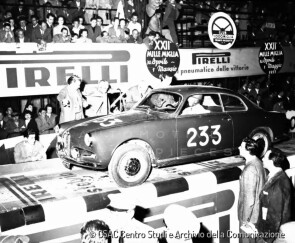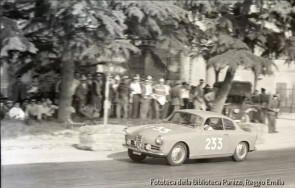
1955 Alfa Romeo Giulietta Sprint
ON/OFF
Why am I an Automotive Masterpiece?
The post-war economic development urged the automotive industry: the mass motorization began and the “artisan” dimensions and settings had to leave space to the logic of the “assembly line” on a large scale, to face the customers’ requests. For Alfa Romeo this delicate passage coincides with the design and construction of the “Giulietta” model. That was born first as a coupe and then as a sedan! The Giulietta, internally referred to as “Type 750”, underwent technical problems that slowed the beginning of the production, compared to the scheduled presentation at the Turin Motor Show in 1954. The production of the car was financed by a public subscription of capital and tied to a national lottery that was giving away a car: the launch could not be procrastinated. For this reason, at the end of 1953, Alfa Romeo took the unusual decision to present the coupé model before the sedan. The sporting version was designed to strengthen the link between the new model and the brand tradition in competitions. The original company program was to set it up on the sedan’s mechanics and put on sale it later, with a limited production by Milan coachbuilders. The design and development of the coupé was completed together with the sedan. The prototype created by Giuseppe Scarnati, later became famous as the “brutto anatroccolo” (ugly duckling). Body shops like Zagato and Touring were unavailable as they were already saturated with other Alfa Romeo models. In charge of the Giulietta project, Rudolf Hruska asked for the help of Mario Boano, manager of Ghia and Bertone and enlisted Giovanni Michelotti as a consultant. Franco Scaglione and a very young Giorgetto Giugiaro also worked on the refinement work, mainly carried out by Boano. The countless changes, while respecting the original volumes, made the body pleasant and balanced. This is how the Giulietta Sprint was born, presented as a pre-series prototype at the Turin Motor Show on 19 March 1954. As usual, the “small” 1,300 cc engine was a twin-camshaft with overhead cams and its rumblewas that of an Alfa! The success of the new model was such that Alfa Romeo immediately had to revise its production programs. The Carrozzeria Bertone had to cope with the unexpected orders of Alfa Romeo, subcontracting the construction of the bodywork to sheet-metal artisans in Turin. In 1960 began the automated production of molding of the shells, hand-made until then. The construction of the Giulietta Sprint took place in Turin for the bodies, then they were sent to Milan at the Portello with car transporters, where they were completed by the engine, the mechanical parts and all the interiors. The Sprint engine, thanks to a higher compression ratio than the sedan and a double-barrel carburetor reached 65 horses and the car thus reached 160 km/h. The body lines and the price of Lit. 1.900.000 contributed to the success. The price, not in absolute terms, was however much lower than the one of the older sister 1900 Super Sprint. It was sold only in four colors: Rosso Alfa, Blu Tornado, Bianco Gardenia and Azzurro Capri. It made his racing debut at the Giro di Sicilia in 1955 and from there his presence spread in all the biggest competitions of the time. The operation of fitting the Giulietta Sprint in a more popular band was very successful. The Giulietta sedan will arrive in the spring of 1955, while in the fall, at the Frankfurt Motor Show, the Spider will see the light. The sales figures of the Giulietta range immediately reached significant values: from 12 units built in 1954, it passed to 1,415 in 1955 and to 1,855 in 1956. The price of the Sprint will rise slightly and the car will receive continuous updates, including: a different gearbox with Porsche synchronizers in place of the Borg-Warner. The construction was then unified to the Sprint Veloce. Between alternating events, the Sprint came out of the price list only in 1966. About 28,000 cars were built in total.
On February 1955, Agostino Di Stefano, a wealthy man from Milan, bought the Giulietta Sprint, chassis n° AR1493*00094* at the Minetti’s Alfa Romeo dealership. He paid the car Lit. 1.903.000. The Giulietta was in red Alfa solid color and it was homologated with the license plate number MI264593 on 25 February; it was delivered on February 26th. The Alfa Romeo Giulietta Sprint, year 1955, chassis n° AR1493*00094* is one of the very first Giulietta Sprint built (date of production 21 February 1955). The Giulietta production began with the Sprint in 1954 with a dozen units produced that year. This car, chassis n° 00094 is considered in fact still a “pre-series” since, from the car chassis number 00996, important changes will be introduced and from 1957 began an even more modified series. The 2nd series dates 1959. Agostino Di Stefano had a real passion for the cars since he was a kid and he dreamed to drive in a race his grandfather’s Bugatti a day. Also he joined in many competitions, although not belonging to any racing team, from 1948 onwards, always with his cars. Because he was 41 years old, he decided to compete in the Mille Miglia with the new little sport car, famous for the handling and light enough to let him to drive for 1624 km in in a quite relaxing way. Chassis n° AR1493*00094*faced the Mille Miglia with race number 233, ranking 130th overall and 13th in class, completing the path in 15h 32’46”. It was the only (successful) participation of Agostino Di Stefano to the Mille Miglia. He also registered in 1951, 1954, 1956, 1957 with other cars, but he never started. Chassis n° AR1493*00094*after a long period of conservation but relative neglect, it was found in 2016 in a state of barn find. Complete, but with many important works to be done. The car has been sold and has undergone a long and deep restoration, completed in 2019, to bring it back to the state of the art. In exceptional condition, the car was recently sold to a new owner. The Centro Documentazione Alfa Romeo historical register also certifies that the actual engine, AR 1315 00186, is original and matching numbers.






